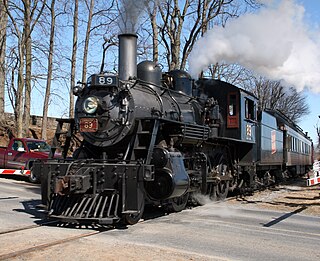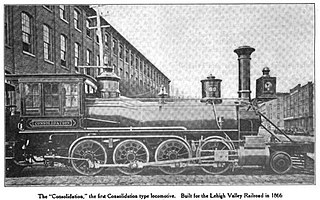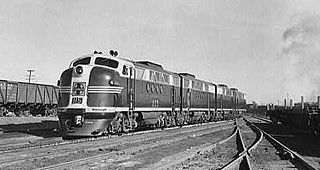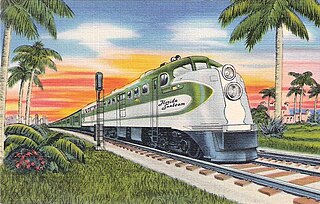
A locomotive or engine is a rail transport vehicle that provides the motive power for a train. If a locomotive is capable of carrying a payload, it is usually rather referred to as a multiple unit, motor coach, railcar or power car; the use of these self-propelled vehicles is increasingly common for passenger trains, but rare for freight.

The American Locomotive Company was an American manufacturer of locomotives, diesel generators, steel, and tanks that operated from 1901 to 1969. The company was formed by the merger of seven smaller locomotive manufacturers and Schenectady Locomotive Engine Manufactory of Schenectady, New York. A subsidiary, American Locomotive Automobile Company, designed and manufactured automobiles under the Alco brand from 1905 to 1913. ALCO also produced nuclear reactors from 1954 to 1962.

A diesel locomotive is a type of railway locomotive in which the power source is a diesel engine. Several types of diesel locomotives have been developed, differing mainly in the means by which mechanical power is conveyed to the driving wheels. The most common are diesel-electric locomotives and diesel-hydraulic.

A 2-8-8-4 steam locomotive, under the Whyte notation, has two leading wheels, two sets of eight driving wheels, and a four-wheel trailing truck. The type was generally named the Yellowstone, a name given it by the first owner, the Northern Pacific Railway, whose lines ran near Yellowstone National Park. Seventy-two Yellowstone-type locomotives were built for four U.S. railroads.

Under the Whyte notation for the classification of steam locomotives, 2-6-0 represents the wheel arrangement of two leading wheels on one axle, usually in a leading truck, six powered and coupled driving wheels on three axles and no trailing wheels. This arrangement is commonly called a Mogul.

Under the Whyte notation for the classification of steam locomotives, 2-8-0 represents the wheel arrangement of two leading wheels on one axle, usually in a leading truck, eight powered and coupled driving wheels on four axles, and no trailing wheels. In the United States and elsewhere, this wheel arrangement is commonly known as a Consolidation, after the Lehigh and Mahanoy Railroad’s Consolidation, the name of the first 2-8-0.

The EMD FT is a 1,350-horsepower (1,010 kW) diesel-electric locomotive that was produced between March 1939 and November 1945, by General Motors' Electro-Motive Corporation (EMC), later known as GM Electro-Motive Division (EMD). The "F" stood for Fourteen Hundred (1400) horsepower and the "T" for Twin, as it came standard in a two-unit set. The design was developed from the TA model built for the C,RI&P in 1937, and was similar in cylinder count, axle count, length, and layout. All told 555 cab-equipped ”A” units were built, along with 541 cabless booster or ”B” units, for a grand total of 1,096 units. The locomotives were all sold to customers in the United States. It was the first model in EMD's very successful F-unit series of cab unit freight diesels and was the locomotive that convinced many U.S. railroads that the diesel-electric freight locomotive was the future. Many rail historians consider the FT one of the most important locomotive models of all time.

The St. Louis–San Francisco Railway, commonly known as the "Frisco", was a railroad that operated in the Midwest and South Central United States from 1876 to April 17, 1980. At the end of 1970, it operated 4,547 miles (7,318 km) of road on 6,574 miles (10,580 km) of track, not including subsidiaries Quanah, Acme and Pacific Railway and the Alabama, Tennessee and Northern Railroad; that year, it reported 12,795 million ton-miles of revenue freight and no passengers. It was purchased and absorbed into the Burlington Northern Railroad in 1980. Despite its name, it never came close to San Francisco.

The Consolidation Line was a series of diesel-electric railway locomotive designs produced by Fairbanks-Morse and its Canadian licensee, the Canadian Locomotive Company. Railfans have dubbed these locomotives “C-liners”, however F-M referred to the models collectively as the C-Line. A combined total of 165 units were produced by F-M and the CLC between 1950 and 1955.

The Wiscasset, Waterville and Farmington Railway is a 2 ft narrow gauge railway. The line was operated as a for-profit company from 1895 until 1933 between the Maine towns of Wiscasset, Albion, and Winslow, but was abandoned in 1936. Today, about three miles (4.8 km) of the track in the town of Alna has been rebuilt and is operated by the non-profit Wiscasset, Waterville and Farmington Railway Museum as a heritage railroad offering passenger excursion trains and hauling occasional cargo.

The ALCO DL-109 was one of six models of A1A-A1A diesel locomotives built to haul passenger trains by the American Locomotive Company (ALCO) between December, 1939 and April, 1945. They were of a cab unit design, and both cab-equipped lead A units DL-103b, DL-105, DL-107, DL-109 and cabless booster B units DL-108, DL-110 models were built. The units were styled by noted industrial designer Otto Kuhler, who incorporated into his characteristic cab the trademark three-piece windshield design. A total of 74 cab units and four cabless booster units were built.
The ALCO DL-202-2 and DL-203-2 diesel-electric locomotive was an experimental freight locomotive produced by ALCO of Schenectady, New York. The primary diesel builders Alco, Baldwin and EMD pushed the War Production Board (WPB) for more opportunities to build more diesels. The Transportation Equipment Division of the WPB announced a production schedule on December 10, 1943, that allowed Alco to build one 4500 horsepower experimental diesel locomotive. This experimental diesel locomotive was to be built in the fourth quarter of 1944. The two A units were built in January 1945 and the B unit at a later date in 1945. The two A units were put on test at Building No. 37 at Schenectady to work out problems with the connecting rods and turbocharger in the Alco 241 engine, developed by both McIntosh and Seymour and ALCo. The total production run included 2 cab DL202-2 A units, and a single DL203-2 B unit. The locomotives were powered by a V12 ALCO 241 diesel engine, rated at 1,500 hp (1.1 MW). The units were released for test in September 1945. The locomotive could attain a top speed of 80 mph (130 km/h) (Freight) and 125 mph (201 km/h) (Passenger). With the B-B wheel arrangement and carbody construction, equipment layout and electrical gear these experimental units were the immediate predecessors of the FA units to come in early 1946. Outwardly, the bodies strongly resembled those on the DL-109, some of which were still under construction at Schenectady in early 1945.
Maine Central Railroad Class W locomotives were intended for heavy freight service. They were of 2-8-0 wheel arrangement in the Whyte notation, or "1'D" in UIC classification. They replaced earlier class O 4-6-0 locomotives beginning in 1910. They were in turn replaced by class S 2-8-2 locomotives for the heaviest freight service beginning in 1914, but remained in use on lighter freight trains until replaced by diesel locomotives after World War II.
Maine Central Railroad Class O locomotives were originally intended for heavy freight service. They were of 4-6-0 wheel arrangement in the Whyte notation, or "2'C" in UIC classification. They replaced earlier class P 2-6-0 locomotives beginning in 1903. They were in turn replaced by class W 2-8-0 locomotives for the heaviest freight service beginning in 1910, but remained in use on branch line trains until replaced by diesel locomotives after World War II. They proved so well-suited for branch line service the design was among the last steam locomotives built for the Maine Central.
Maine Central Railroad Class C locomotives were intended for main line passenger service. They were of 4-6-2 wheel arrangement in the Whyte notation, or " 2'C1' " in UIC classification. They replaced earlier class N 4-6-0 locomotives beginning in 1907. Class C locomotives pulled named passenger trains until replacement by diesel locomotives after World War II.
Maine Central Railroad steam switchers were designated Class K. They were of 0-6-0 wheel arrangement in the Whyte notation, or "C" in UIC classification. American Locomotive Company (ALCO) began building more powerful yard locomotives for Maine Central in 1909. Twenty locomotives numbered 161 through 180 were active in 1923, and worked in Maine's largest cities until replaced by diesels after World War II.
Maine Central Railroad Class M locomotives were originally intended for heavy freight service. They were of 2-6-0 wheel arrangement in the Whyte notation, or "1'C" in UIC classification. They were replaced by class P 2-6-0 locomotives for the heaviest freight service beginning in 1896, and spent their final years as yard switchers. The oldest of the class surviving past United States Railroad Administration operation were Portland Company builders numbers 606 and 607 built in 1890. Eleven built by Schenectady Locomotive Works in 1893 and 1894 also appeared in the 221-245 number sequence on Maine Central's 1923 locomotive roster. The longest surviving representatives of the class were three built by Schenectady in 1897 as Portland and Rumford Falls Railway numbers 10 through 12. These three were rebuilt with higher-pressure boilers in Maine Central's Waterville shop between 1914 and 1921 as sub-class M-5. These reboilered locomotives with 25,000 lbf (111.2 kN) tractive effort were numbered 246 through 248. Number 247 was the last survivor of the class when scrapped in 1946.
Maine Central Railroad Class P locomotives were originally intended for heavy freight service. They were of 2-6-0 wheel arrangement in the Whyte notation, or "1'C" in UIC classification. They replaced class M 2-6-0s for the heaviest freight service beginning in 1896. They were transferred to branch line service as replaced by class O 4-6-0 locomotives beginning in 1903. Most were scrapped during the Great Depression and none survived World War II.
Maine Central Railroad began operating diesel locomotives in 1935, and had retired all steam locomotives by 1954. That time interval was a joint operating period with the Boston and Maine Railroad (B&M). This article describes diesel locomotives owned by Maine Central through the period of joint operation and later independent operation prior to Guilford Rail System control in 1981.












